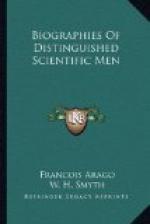FOOTNOTE:
[17] These titles are copied direct from the Philosophical Transactions, instead of being retranslated.—Translator’s Note.
IMPROVEMENTS IN THE MEANS OF OBSERVATION.
The improvements that Herschel made in the construction and management of telescopes have contributed so directly to the discoveries with which that observer enriched astronomy, that we cannot hesitate to bring them forward at once.
I read the following passage in a Memoir by Lalande, printed in 1783, and forming part of the preface to vol. viii. of the Ephemerides of the Celestial Motions.
“Each time that Herschel undertakes to polish a mirror (of a telescope), he condemns himself to ten, or twelve, or even fourteen hours’ constant work. He does not quit his workshop for a minute, not even to eat, but receives from the hands of his sister that nourishment without which one could not undergo such prolonged fatigue. Nothing in the world would induce Herschel to abandon his work; for, according to him, it would be to spoil it.”
The advantages that Herschel found in 1783, 1784, and 1785, in employing telescopes of twenty feet and with large apertures, made him wish to construct much larger still. The expense would be considerable; King George III. provided for it. The work, begun about the close of 1785, was finished in August, 1789. This instrument had an iron cylindrical tube, thirty-nine feet four inches English in length, and four feet ten inches in diameter. Such dimensions are enormous compared with those of telescopes made till then. They will appear but small, however, to persons who have heard the report of a pretended ball given in the Slough telescope. The propagators of this popular rumour had confounded the astronomer Herschel with the brewer Meux, and a cylinder in which a man of the smallest stature could scarcely stand upright, with certain wooden vats, as large as a house, in which beer is made and kept in London.
Herschel’s telescope, forty English feet[18] in length, allowed of the realization of an idea, the advantages of which would not be sufficiently appreciated if I did not here recall to mind some facts.
In any telescope, whether refracting or reflecting, there are two principal parts: the part that forms the aerial images of the distant objects, and the small lens by the aid of which these images are enlarged just as if they consisted of radiating matter. When the image is produced by means of a lenticular glass, the place it occupies will be found in the prolongation of the line that extends from the object to the centre of the lens. The astronomer, furnished with an eye-piece, and wishing to examine that image, must necessarily place himself beyond the point where the rays that form it have crossed each other; beyond, let us carefully remark, means farther off from the object-glass. The observer’s




